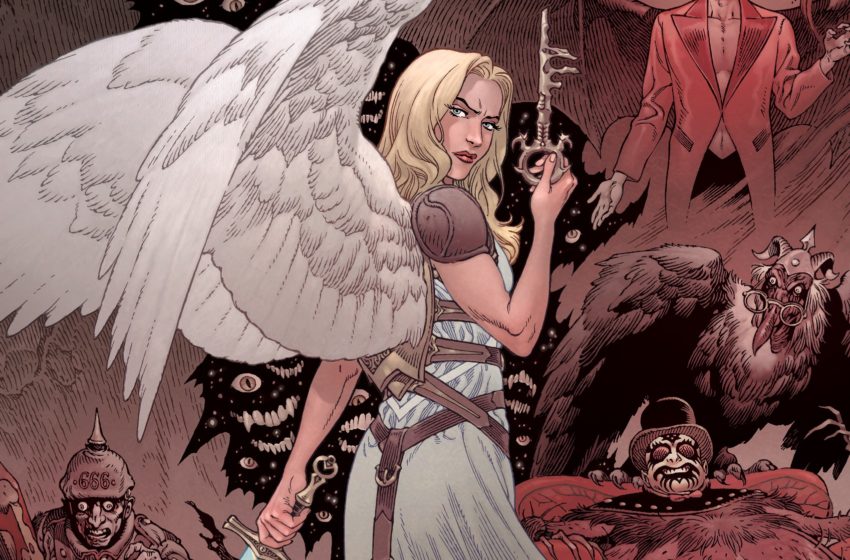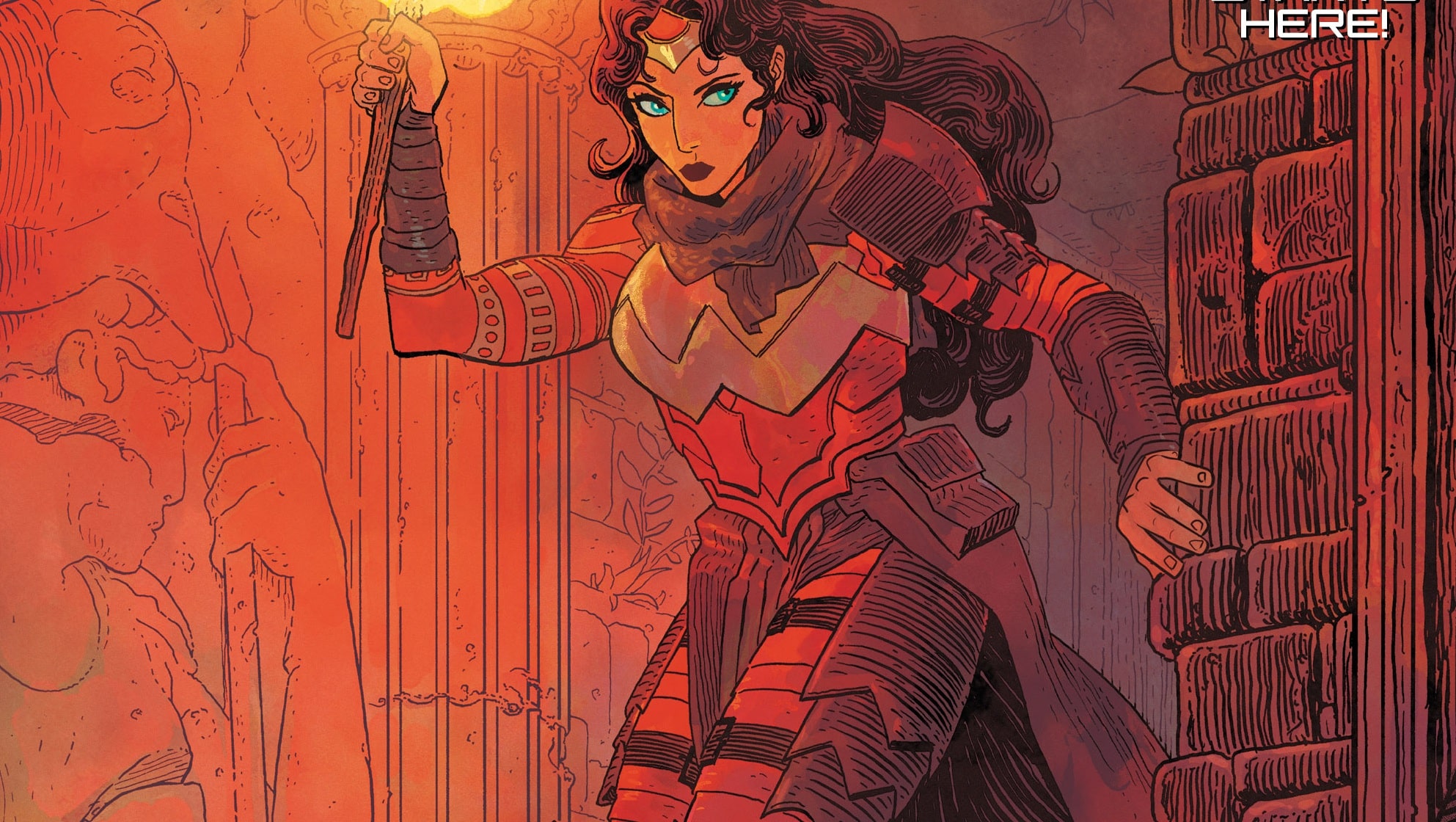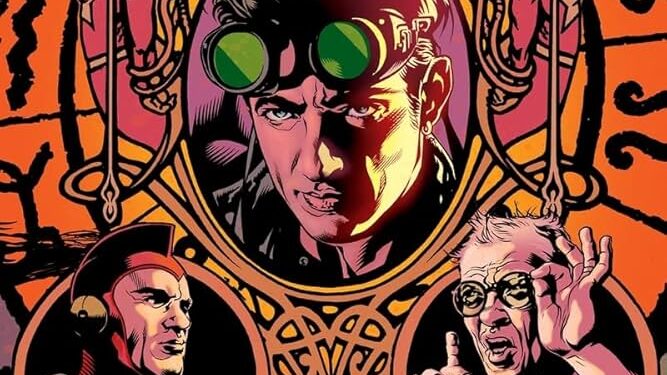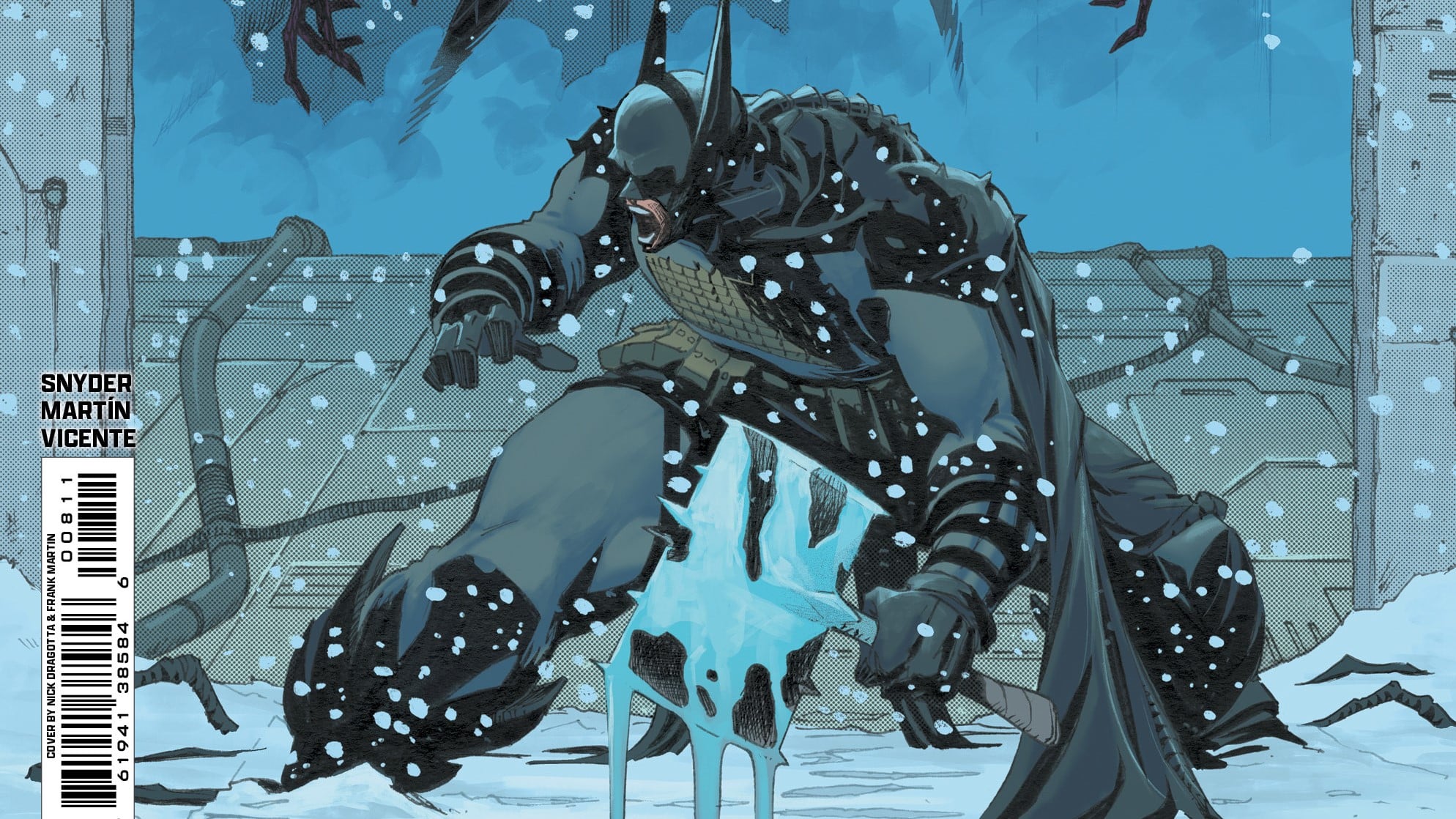Armed with Dream’s manifestations of power, Mary Locke has made her way to the Dreaming in the hopes of finding a way to Hell to retrieve her lost brother’s soul. Hell isn’t the easiest place to get into, but the Lockes have always managed to find that one key thing that gets them what they need the most. Locke & Key/Sandman: Hell & Gone #2 is told by Gabriel Rodriguez and Joe Hill, colored by Jay Fotos and lettered by Shawn Lee for DC and IDW.
Armaan Babu: This comic feels like it’s been teased for far too long, and far too many times. There’s been so much delay with this, and so much buildup. Even when the first issue finally came out, a lot of it felt like it was a little more setup than story. Perhaps, though, that’s just in comparison, because this issue here? It feels like we’re finally getting the story we’ve been waiting for for a very long time. What do you think, Matt?
Matt Lazorwitz: This is what a lot of fans who were waiting for this crossover were expecting. While the first issue used a few characters from The Sandman, they were mostly the Burgesses until the very end of the issue. This time, we start off in the Dreaming, and we run with mostly Sandman characters all the way until the very end. It’s exciting, gorgeous and at times deeply heartfelt. Exactly what I was hoping for.
Armaan: I … tried to hold out, but I just couldn’t: Matt, it sounds like your dreams all came true!
Familiar Faces and Too Many Teeth

Armaan: So we open right where we left off last issue, with Mary Locke taking a tour of Dream’s library, unaware that her guide is the murderous nightmare known only as the Corinthian. Or seemingly unaware, at least, because in a few short pages she turns the tables right on him, and with the clumsy but well-intentioned help of Fiddler’s Green and Morpheus’ magic, manages to banish the Corinthian out of the Dreaming, which is apparently how he escaped in the first place.
There’s a lot of that going on in this comic — setups for what comes later, callbacks to fan-favorite moments. It’s a little heavy handed, and something that takes me out of the story a little bit, but then the characters turn on the charm and I’m brought right back in.
How’ve you enjoyed this classic Dreaming supporting cast reunion?
Matt: Well, first, you absolutely hit the nail on the head about the callbacks to The Sandman. There were some absolute groaners in here that did throw me, especially later, with Alex Burgess saying he could dream forever. I expected a trombone sting to that one. Hill has had a few of those in his novels as well, these hard winks to Stephen King’s works (if anyone is unaware, Hill is King’s eldest son).
But I was able to get past that pretty quickly, because Hill’s script is very engaging otherwise. He has the voices of these characters down cold. The Corinthian’s sinister creepiness, Gilbert’s bluster, Lucien’s fussiness. It was like visiting old friends.
And Gabriel Rodriguez draws an utterly disquieting Corinthian. The tongues in his eye mouths? *shudder*
Armaan: Those were bad, and, you know, Matt? It wasn’t that the eye teeth had tongues, or that the eye teeth even existed at all. It’s that they looked gleeful.
Between the impeccable Fotos coloring and the Rodriguez art, every panel of this book is gorgeous, but Rodriguez always puts that little extra something into the darkness of his books. The evil we see here isn’t just gruesome, it’s personal, it’s joyful, it’s a celebration of maliciousness. It is, in short, the perfect art to visit Hell with, and I’m deeply amused with the simplicity of how they get there.
One thing I love about more old-fashioned lore regarding Hell is that it is bound by rules, perhaps more tightly than any other plane of existence. While this is terrible for D&D players trying to figure out fine print in the middle of their fantasy games, it’s excellent for storytelling — you can establish the rules fairly quickly, and once you do that, you know the stakes.
Once Mary finds out the key to Hell is … well, a literal key, she gets right round to making one, as the Lockes have done for generations. This makes everything within Hell fall immediately under her purview — that is, until someone can figure out whether her key or Lucifer’s is the real one. Which brings us to the last thing they need to get into hell.
Gone, well, the perfect plan.
Enter the demon, Etrigan!
(I’m sorry, it doesn’t feel right to have him show up without a rhyme in place).
Matt: There’s a lot to unpack in these scenes. I enjoy that Etrigan doesn’t rhyme in much of this story. He didn’t rhyme in the earliest Kirby stories, and it’s mostly an Alan Moore thing (I may have just talked about this in a yet-to-be-released BatChat). To give the origin of Etrigan’s ascension to rhyming demon is a neat touch, and it spares Hill trying to write proper rhyming, which can be challenging.
Gilbert is an excellent addition to this story, a good choice of the dream who accompanies Mary. For one, he’s a major character from the Dreaming who hasn’t gotten as much play as many of the others, so there’s not as many plot points to dance around. He’s also a nice foil to Mary, who is a bold and “modern” woman, while he remains old-fashioned and chivalrous. [Grote’s note: An old-fashioned guy? Does he believe that when the giant that holds up the Earth dies, we’re screwed?]
It’s easy to forget just how deeply, darkly personal this is for Mary at this point. It’s a high supernatural adventure, and she’s so focused on the Dreaming and Hell, that we aren’t seeing as much of John, her brother lost in Hell. That is about to change, though …
Hell’s Never Looked So Good

Armaan: My Christian parents would hate me for saying this, but they don’t read comic book reviews anyway, so I’ll just say it: Hell is great. I love Hell here. Hell’s the best part of the book, and we should have all gotten here a lot sooner.
The art really gets to let loose here, and it’s gruesome and magnificent. Even poor Cerberus looks haunted by the stuff his six eyes have seen in there. We get a glimpse of a character from In Pale Battalions Go, with a particularly inventive punishment for his sins. Of course, this is all preamble for the Fallen himself, Lord of Lies and, more pertinently, bearer of the Other True Key of Hell, Lucifer Morningstar. It’s fun seeing him at the height of his glory, all smug, unthreatened and amused by the paradox Mary brings to him.
Out of all the many Sandman callbacks, I think this was the part I enjoyed best — outwitting the Lords of Hell with wordplay, and deeds, and just a little looming danger. Mary, of course, has no time for riddles. She’s a lady who takes the most direct approach possible, which is great for a two-issue series. All the powers of her magic keys against Lucifer’s armies, just to help her brother’s soul escape from Hell.
Before that fight, we get a heartfelt moment between the Locke siblings. This is a book that’s been pretty Sandman heavy, but seeing two siblings be there for each other in the face of powerful weird evil? That’s the kind of thing I loved the original Locke & Key for.
Matt: This definitely becomes more of a Locke & Key story when you reach the point of Mary finding John. It’s the kind of relationship drama Hill did so well throughout that series. That was also a story that explored a similar theme. John believes he is responsible for his mother’s death in the same way that Tyler blames himself for his father’s. And again, it’s coming to terms with all that which allows our protagonists to face down the monsters.
As tough as Dodge was, though, Lucifer is on a whole other level. He brings the armies of hell with him, and the battle royale that ensues is again another shining moment for Rodriguez and Fotos. The winged Mary fighting demons, John wielding the Crown of Shadows, Gilbert fighting with a key-powered sword. The fact that we see not just Lucifer, but Azazel and Beelzebub, the other members of Hell’s triumvirate, in action, and a cameo of Choronzon, the demon Morpheus will eventually have his riddling duel with, just adds to the excitement. It’s an epic battle like you’d expect.
I love the representation of Lucifer in this book. He’s not a full on photo referenced David Bowie as he was in his first appearance, but he’s not as monstrous and contorted as Kelley Jones would make him, or as slick as he’d appear in his own series. There’s definitely an air of Bowie about him, especially in his dress and posture, but he’s got an air of gleeful menace, similar to the Corinthian, but not as moustache-twirly. He is confident in his power, and it shows. And when he goes full devil? That’s a great design!
Armaan: It wouldn’t really be Lucifer if he wasn’t the most handsome devil in the book, now, would it? But as fun as the battle is, it’s got nothing on their escape.
Clavis Ex Machina

Armaan: While the main appeal of Locke & Key for me was the familial bonds, a close second is the keys themselves, and it’s always fun seeing a new one. Gil gets a sword that can cut through anything — be it souls, smoke or speech balloons — but the one that finally saves the day is the most dreamlike key of them all. Gil the man becomes Gil the dream to give our heroes a moon — a moon unlocked by Mary’s final key.
We haven’t reviewed the zero issue for this series, but it comes into play in a big way here. I love the concept of this moon key. There’s no easy way to define it — it’s not a key that makes you big, or controls shadows, or sets your spirit free, this is a key that turns the moon into a place you can reach. Then unlock. Then leave your soul to rest inside like the world’s backstage has been hidden behind the moon all along.
It’s the kind of key you can only describe like you’re describing a dream you had, and as someone who spends a lot of his life backstage, I am incredibly charmed by one being used as a setting for some kind of afterlife. I think this backstage-moon area is the perfect meeting place of the Locke family keys and the Dreaming.
I also really enjoyed the way the book tied up the paradox of there being two keys to Hell — Mary Locke somehow simply wanders into the past, presenting her key to the angels who bind it ‘round Lucifer’s neck, a time loop that takes on this surreal dream-like quality to it. A destiny wrapped up in itself.
The ending of this book might have been a little saccharine, but it worked for me. It’s brought back to familial love, there’s heart here that cannot be denied. Like every good dream, it’s hard to explain just how it works, but I feel left with this pervasive sense of peace and goodwill. Did it have the same effect on you, Matt?
Matt: OK, personal confession time: In my relationship, I am, as my wife likes to say, the shmoopy one. I’m the sentimentalist who tears up at movies and books, who remembers every date that we had a first and has a soft spot for admittedly godawful Hallmark movies. So that makes me an easy mark for an ending that is a bit saccharine and pat. Hill is not as brutal as his father when it comes to killing his leads. Locke & Key ends with the family whole again, even with one seemingly dead until the clavis ex machina (key in the machine for those who didn’t take three years of Latin in high school) that restores them.
And I will also admit to tearing up every time I read Open the Moon, that story that was reprinted in the zero issue that introduces the Moon Key. Hill writes clockwork stories often; while he writes excellent characters, he builds in his endings and knows where they’re going and you can go back and see where he laid his threads (While I’m a devotee of his father, I admit Hill does tend to write better endings than King does). So knowing where all the Dreaming- and Hell-related pieces needed to be at the end, he was able to get to this heartwarming ending. There is death, yes, but there is also Death, and that is a version of the reaper that works with the world of Locke & Key.
This closes another chapter for the Locke family. If you’ve followed the ancillary Locke & Key stories, the ones set in The Golden Age as Hill calls it, we now have a satisfying ending for this generation. And yet Hill is also able to set the places for Sandman Vol.2: The Doll’s House, leaving Gilbert and the Corinthian in the waking world. I’m perfectly happy not seeing any more stories set during Morpheus’ imprisonment, it’s well tread ground at this point, like the time in between Star Wars: A New Hope and The Empire Strikes Back. This story ties a perfect bow on that era as well, and leaves us looking to what’s next for both of these worlds.
Armaan: I am looking forward to what’s happening next in these worlds, definitely, because like you said, this area is well tread ground. It looks like television is beating us to it, however — but in the meantime, I’m deeply pleased with the story we got here.
Other Dreams
- There’s a little reference to the angel Duma impatiently asking where Mary Locke is during the scene in the Silver City. Duma is the angel of silence in The Sandman. I wonder what changes him?
- Making Death’s Ankh a key that opens all doors is a cute touch.
- If someone knows or wants to make up the backstory for the rhino demon with the MOM tattoo, please DM Armaan.







